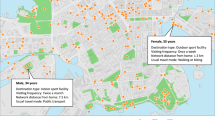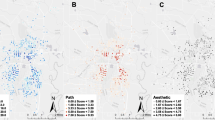Abstract
Background
Studies identifying correlates of physical activity (PA) at all levels of the ecological model can provide an empirical basis for designing interventions to increase older adults’ PA.
Purpose
Applying ecological model principles, this study concurrently examined individual, psychosocial, and environmental correlates of older adults’ PA to determine whether built environment factors contribute to PA over and above individual/demographic and psychosocial variables.
Methods
Using a cross-sectional observational design, 726 adults, aged ≥66 years, were recruited from two US regions. Explanatory variables included demographics, self-efficacy, social support, barriers, and environmental variables measured by using geographic information systems (GIS) and self-report. Outcomes included reported walking for errands and leisure/exercise and accelerometer-measured daily moderate to vigorous PA (MVPA). Analyses employed mixed-model regressions with backward elimination.
Results
For daily MVPA, the only significant environmental variable was GIS-based proximity to a park (p < 0.001) after controlling for individual/demographic and psychosocial factors. Walking for errands was positively related to four environmental variables: reported walking/cycling facilities (p < 0.05), GIS-based intersection density (p < 0.01), mixed land use (p < 0.01), and private recreation facilities (p < 0.01). Walking for leisure/exercise was negatively related to GIS-based mixed land use (p < 0.05). Non-Hispanic white race/ethnicity, self-efficacy, and social support positively related to all three PA outcomes (p < 0.05).
Conclusions
Correlates of older adults’ PA were found at all ecological levels, supporting multiple levels of influence and need for multilevel interventions. Environmental correlates varied by PA outcome. Walking for errands exhibited the most environmental associations.
Similar content being viewed by others
References
Troiano RP, Berrigan D, Dodd KW, Mâsse LC, Tilert T, McDowell M. Physical activity in the United States measured by accelerometer. Med Sci Sports Exerc. 2008;40(1):181–8. doi: 10.1249/mss.0b013e31815a51b3.
Bellavia A, Bottai M, Wolk A, Orsini N. Physical activity and mortality in a prospective cohort of middle-aged and elderly men—a time perspective. Int J Behav Nutr Phys Act. 2013;10:94. doi: 10.1186/1479-5868-10-94.
Sun F, Norman IJ, While AE. Physical activity in older people: a systematic review. BMC Public Health. 2013;13(1):449. doi: 10.1186/1471-2458-13-449.
US Department of Health and Human Services (HHS), Office of Disease Prevention and Health Promotion. 2008 Physical Activity Guidelines for Americans. Washington: HHS; 2008.
U.S. Department of Health and Human Services. Step It Up! The Surgeon General’s Call to Action to Promote Walking and Walkable Communities. Washington, DC: U.S. Dept of Health and Human Services, Office of the Surgeon General; 2015.
Sallis JF, Owen N. Ecological models of health behavior. In: Glanz K, Rimer BK, Viswanath K, eds. Health behavior and health education: theory, research, and practice. 5th ed. San Francisco: Jossey-Bass; 2015:43–64.
Michie S, Johnston M, Francis J, Hardeman W, Eccles M. From theory to intervention: mapping theoretically derived behavioural determinants to behaviour change techniques. Appl Psychol. 2008;57(4):660–680. doi: 10.1111/j.1464-0597.2008.00341.x.
Frank LD, Kerr J, Rosenberg D, King A. Healthy aging and where you live: community design relationships with physical activity and body weight in older Americans. J Phys Act Health. 2010;7 Suppl 1:S82–90. doi: 10.1177/0885412211415283.
Van Cauwenberg J, De Bourdeaudhuij I, De Meester F, et al. Relationship between the physical environment and physical activity in older adults: a systematic review. Health Place. 2011;17(2):458–469. doi: 10.1016/j.healthplace.2010.11.010.
Giles-Corti B, Timperio A, Bull F, Pikora T. Understanding physical activity environmental correlates: increased specificity for ecological models. Exerc Sport Sci Rev. 2005;33(4):175–81. doi: 10.1097/00003677-200510000-00005.
Kerr J, Rosenberg D, Frank L. The role of the built environment in healthy aging: community design, physical activity, and health among older adults. J Plan Lit. 2012;27(1):43–60. doi: 10.1177/0885412211415283.
Nagel CL, Carlson NE, Bosworth M, Michael YL. The relation between neighborhood built environment and walking activity among older adults. Am J Epidemiol. 2008;168(4):461–8.
Michael YL, Perdue LA, Orwoll ES, Stefanick ML, Marshall LM. Physical activity resources and changes in walking in a cohort of older men. Am J Public Health. 2010;100(4):654–60.
Sallis JF, King AC, Sirard JR, Albright CL. Perceived environmental predictors of physical activity over 6 months in adults: activity counseling trial. Health Psychol. 2007;26(6):701–9. doi: 10.1037/0278-6133.26.6.701.
Shigematsu R, Sallis JF, Conway TL, et al. Age differences in the relation of perceived neighborhood environment to walking. Med Sci Sports Exerc. 2009;41(2):314–21. doi: 10.1249/mss.0b013e318185496c.
Lin L, Moudon AV. Objective versus subjective measures of the built environment, which are most effective in capturing associations with walking?. Health Place. 2010;16(2):339–48. doi: 10.1016/j.healthplace.2009.11.002.
King AC, Sallis JF, Frank LD, et al. Aging in neighborhoods differing in walkability and income: associations with physical activity and obesity in older adults. Soc Sci Med. 2011;73(10):1525–33. doi: 10.1016/j.socscimed.2011.08.032.
Strath SJ, Greenwald MJ, Isaacs R, et al. Measured and perceived environmental characteristics are related to accelerometer defined physical activity in older adults. Int J Behav Nutr Phys Act. 2012;9(1):40. doi: 10.1186/1479-5868-9-40.
Sallis JF, Cervero RB, Ascher W, Henderson KA, Kraft MK, Kerr J. An ecological approach to creating active living communities. Annu Rev Public Health. 2006;27:297–322. doi: 10.1146/annurev.publhealth.27.021405.102100.
Saelens BE, Sallis JF, Frank LD. Environmental correlates of walking and cycling: findings from the transportation, urban design, and planning literatures. Ann Behav Med. 2003;25(2):80–91. doi: 10.1207/s15324796abm2502_03.
Frank LD, Sallis JF, Saelens BE, et al. The development of a walkability index: application to the neighborhood quality of life study. Br J Sports Med. 2010;44(13):924–33. doi: 10.1136/bjsm.2009.058701.
Freedson PS, Melanson E, Sirard J. Calibration of the computer science and applications, Inc. accelerometer. Med Sci Sports Exerc. 1998;30(5):777–81. doi: 10.1097/00005768-199805000-00021.
Stewart AL, Mills KM, King AC, Haskell WL, Gillis D, Ritter PL. CHAMPS physical activity questionnaire for older adults: outcomes for interventions. Med Sci Sports Exerc. 2001;33(7):1126–41. doi: 10.1097/00005768-200107000-00010.
Harada ND, Chiu V, King AC, Stewart AL. An evaluation of three self-report physical activity instruments for older adults. Med Sci Sports Exerc. 2001;33(6):962–70. doi: 10.1097/00005768-200106000-00016.
Sayers S, Jette A, Haley S, Heeren T, Guralnik J, Fielding R. Validation of the late-life function and disability instrument. J Am Geriatr Soc. 2004;52(9):1554–1559. doi: 10.1111/j.1532-5415.2004.52422.x.
Jette AM, Haley SM, Coster WJ, et al. Late life function and disability instrument I. Development and evaluation of the disability component. J Gerontol A Biol Sci Med Sci. 2002;57(4):M209–16. doi: 10.1093/gerona/57.4.m209.
Garcia A, King A. Predicting long-term adherence to aerobic exercise: a comparison of two models. J Sport Exerc Psychol. 1991;13:394–410.
Marcus BH, Rakowski W, Rossi JS. Assessing motivational readiness and decision making for exercise. Health Psychol. 1992;11(4):257–61. doi: 10.1037//0278-6133.11.4.257.
Sallis JF, Grossman RM, Pinski RB, Patterson TL, Nader PR. The development of scales to measure social support for diet and exercise behaviors. Prev Med. 1987;16(6):825–36. doi: 10.1016/0091-7435(87)90022-3.
Villanueva K, Knuiman M, Nathan A, et al. The impact of neighborhood walkability on walking: does it differ across adult life stage and does neighborhood buffer size matter?. Health Place. 2014;25:43–6. doi: 10.1016/j.healthplace.2013.10.005.
Abercrombie LC, Sallis JF, Conway TL, Frank LD, Saelens BE, Chapman JE. Income and racial disparities in access to public parks and private recreation facilities. Am J Prev Med. 2008;34(1):9–15. doi: 10.1016/j.amepre.2007.09.030.
Saelens BE, Sallis JF, Black JB, Chen D. Neighborhood-based differences in physical activity: an environment scale evaluation. Am J Public Health. 2003;93(9):1552–8. doi: 10.2105/ajph.93.9.1552.
McNeill LH, Wyrwich KW, Brownson RC, Clark EM, Kreuter MW. Individual, social environmental, and physical environmental influences on physical activity among black and white adults: a structural equation analysis. Ann Behav Med. 2006;31(1):36–44. doi: 10.1207/s15324796abm3101_7.
Saelens BE, Sallis JF, Frank LD, et al. Neighborhood environment and psychosocial correlates of adults’ physical activity. Med Sci Sports Exerc. 2012;44(4):637–46. doi: 10.1016/j.ypmed.2011.10.004.
Shimura H, Sugiyama T, Winkler E, Owen N. High neighborhood walkability mitigates declines in middle-to-older aged adults’ walking for transport. J Phys Act Health. 2012;9(7):1004–8. doi: 10.1123/jpah.2012-0244.
Van Holle V, Van Cauwenberg J, Van Dyck D, Deforche B, Van de Weghe N, De Bourdeaudhuij I. Relationship between neighborhood walkability and older adults’ physical activity: results from the Belgian environmental physical activity study in seniors (BEPAS seniors). Int J Behav Nutr Phys Act. 2014;11(1). doi: 10.1186/s12966-014-0110-3.
Lachapelle U, Frank LD. Transit and health: mode of transport, employer-sponsored public transit pass programs, and physical activity. J Public Health Policy. 2009;30 Suppl 1:S73–94. doi: 10.1057/jphp.2008.52.
Michael YL, Perdue LA, Orwoll ES, Stefanick ML, Marshall LM. Physical activity resources and changes in walking in a cohort of older men. Am J Public Health. 2010;100(4):654–60. doi: 10.2105/ajph.2009.172031.
Gómez LF, Parra DC, Buchner D, et al. Built environment attributes and walking patterns among the elderly population in Bogotá. Am J Prev Med. 2010;38(6):592–99. doi: 10.1016/j.amepre.2010.02.005.
Tappe KA, Glanz K, Sallis JF, Zhou C, Saelens BE. Children’s physical activity and parents’ perception of the neighborhood environment: neighborhood impact on kids study. Int J Behav Nutr Phys Act. 2013;10:39. doi: 10.1186/1479-5868-10-39.
Ding D, Sallis JF, Conway TL, et al. Interactive effects of built environment and psychosocial attributes on physical activity: a test of ecological models. Ann Behav Med. 2012;44(3):365–74. doi: 10.1007/s12160-012-9394-1.
Bandura, A. Social foundations of thought and action. New Jersey: Englewood Cliffs; 1986.
Trost SG, Owen N, Bauman AE, Sallis JF, Brown W. Correlates of adults’ participation in physical activity: review and update. Med Sci Sports Exerc. 2002;34(12):1996–2001. doi: 10.1097/00005768-200212000-00020.
Macera C, Cavanaugh A, Bellettiere J. State of the art review: physical activity and older adults. Am J Lifestyle Med. 2015. doi: 10.1177/1559827615571897.
Newson RS, Kemps EB. Factors that promote and prevent exercise engagement in older adults. J Aging Health. 2007;19(3):470–81. doi: 10.1177/0898264307300169.
Smith K, Carr K, Wiseman A, Calhoun K, McNevin N, Weir P. Barriers are not the limiting factor to participation in physical activity in Canadian seniors. J Aging Res. 2012;2012: 1–8. doi: 10.1155/2012/890679.
Evenson KR, Buchner DM, Morland KB. Objective measurement of physical activity and sedentary behavior among US adults aged 60 years or older. Prev Chronic Dis. 2012;9: E26. doi: 10.5888/pcd9.110109.
Author information
Authors and Affiliations
Corresponding author
Ethics declarations
Funding
This study was supported by US National Heart, Lung, and Blood Institute grant R01 HL077141. The sponsor had no role in the preparation, review, or approval of the manuscript for publication.
Authors’ Statement of Conflict of Interest and Adherence to Ethical Standards
Authors Christina M. Thornton, Jacqueline Kerr, Terry L. Conway, Brian E. Saelens, James F. Sallis, David K. Ahn, Lawrence D. Frank, Kelli L. Cain, and Abby C. King declare that they have no conflict of interest. All procedures performed in studies involving human participants were in accordance with the ethical standards of the institutional and/or national research committee and with the 1964 Helsinki declaration and its later amendments or comparable ethical standards.
About this article
Cite this article
Thornton, C.M., Kerr, J., Conway, T.L. et al. Physical Activity in Older Adults: an Ecological Approach. ann. behav. med. 51, 159–169 (2017). https://doi.org/10.1007/s12160-016-9837-1
Published:
Issue Date:
DOI: https://doi.org/10.1007/s12160-016-9837-1




